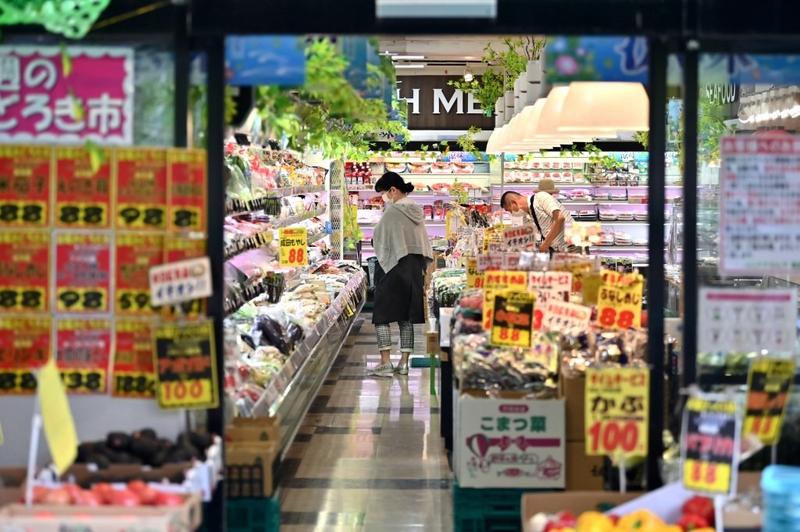 People are pictured in a supermarket in Tokyo on June 9, 2020. (PHOTO / AFP)
People are pictured in a supermarket in Tokyo on June 9, 2020. (PHOTO / AFP)
TOKYO — The coronavirus has forced Japan’s notoriously fussy food shoppers to abandon doubts about online grocery stores, sending retailers such as Aeon Co scrambling to meet a surge in delivery demand.
Although Japanese shoppers aren’t alone in going online during the outbreak, the shift is remarkable for a country that had been expected to take years to embrace online food shopping because of a zeal for fresh and perfectly presented produce.
“I think that this pandemic has triggered an inflection point in the adoption of grocery e-commerce,” said Luke Jensen, executive director of Ocado Group, hired to build a grocery e-commerce business for Japanese retail giant Aeon.
Most companies won’t disclose numbers, but retail executives and analysts estimate internet sales now account for about 5 percent or more of Japan’s total grocery sales, compared with 2.5 percent before the pandemic
ALSO READ: Tokyo braces for critical weekend to contain virus outbreak
Most companies won’t disclose numbers, but retail executives and analysts estimate internet sales now account for about 5 percent or more of Japan’s total grocery sales, compared with 2.5 percent before the pandemic.
Although that is still lower than some pre-crisis estimates of 15 percent in China and even 7 percent in broadband laggard Britain, it challenges a long-held belief that Japanese shoppers will always on shopping daily and in person, checking the goods first-hand.
Yuri Ohtaka, a graphic designer living in Tokyo’s western suburbs, began ordering from multiple online supermarkets in March after seeing shoppers emptying shelves at a nearby store.
Although fears of shortages have subsided, online deliveries have made it easier as she works from home, making three meals a day for her family, including her 3-year-old son. She’s also happy to avoid stores amid fears of infections.
“There’s no need for face-to-face, dealing with registers, or standing in line,” she said, adding that she’s also persuaded her parents to go online. “They were shopping every day in the supermarket, and I really didn’t want them to.”
As more households have two people working, analysts say, people want to spend less time shopping. But they still have exacting standards for service and produce quality, which have perplexed previous foreign entrants such as Carrefour and Tesco.
Such changes are closely watched as Japan is one of the world’s most valuable grocery markets, worth over 50 trillion yen (US$466.42 billion) a year. Per capita, only countries such as Switzerland, Norway and Israel spend more on food.
Sudden demand
Major Japanese supermarkets, despite talking about online services for years, have only recently begun large-scale spending on e-commerce infrastructure.
Most have struggled to meet the spike in demand, and would-be-shoppers on Twitter have complained of difficulty securing delivery slots throughout the crisis.
Aeon hired British online grocery pioneer Ocado in November to build state-of-the-art robotic warehouses, aiming to fend off rivals such as Amazon, Seven & i Holdings’ Ito-Yokado and a venture between Walmart-owned Seiyu and e-commerce giant Rakuten Inc.
But the first of those warehouses won’t start operating until 2023. In the meantime, Aeon said it is hiring more staff to help pack online grocery orders, although it is having difficulty hiring more delivery drivers.
Despite such constraints, Aeon expects online grocery sales to grow 50 percent and account for about 10 percent of sales by the end of its financial year ending next February, according to company executives.
That is not an official target unveiled to investors, but the company confirmed President Akio Yoshida, who was appointed to the top job in March, set it as a goal.
Executives expect the shift to last.
“When people increase their use of online, they stay with it rather than going back. In Japan we’d expect there to be a step up in the growth of e-commerce,” said Ocado’s Jensen, who is also chief executive of the group’s Ocado Solutions technology business.
Smart warehouses VS Mom and pop
Analysts say the shift is also likely to favour bigger retailers who can invest in high-tech warehouses capable of handling large volumes rather than just having store staff pick items from retail shelves and package them for delivery.
READ MORE: Japan's Don Quijote rides high on rule-breaking reputation
That could put smaller supermarkets and mom-and-pop stores, already struggling to match the likes of Aeon and Ito-Yokado in pricing, at a further disadvantage.
But Violetta Volovich, who has researched global grocery industry trends for e-commerce consultancy Edge by Ascential, said remote and costly high-tech fulfilment centers were not the answer for all retailers.
Instead, she envisions many retailers adopting automating more jobs in existing brick-and-mortar stores and embracing features such as “click and collect”, in which shoppers pick up online purchases at the stores.
She also said the rise in food e-commerce didn’t mean an end to traditional grocery shopping.
“Just because people get pizza delivery doesn’t mean they will stop going to pizza restaurants,” she said.


